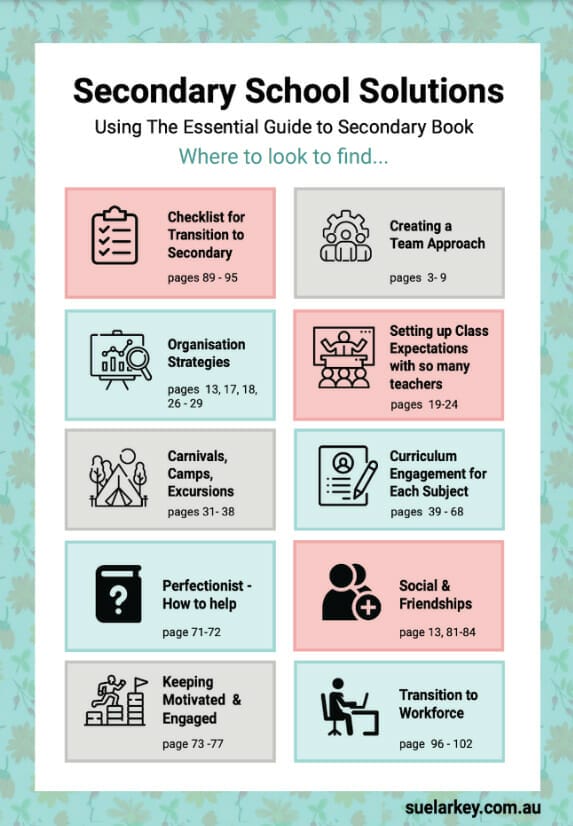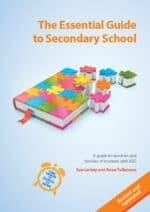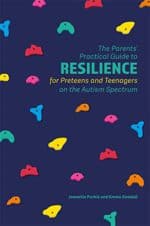Transition from Primary to Secondary School: Interview with Expert Joan Shanahan

**************************************
Join me for an upcoming Workshop:
Can't make these Workshop dates? Join me for a self-paced on-demand course:
Sue Larkey On-Demand Workshops
**************************************
This Weeks Podcast is an interview with the Joan Shanahan:
Joan has been involved in education all her life and experienced from early childhood to tertiary. She finally worked as a consultant in 24 schools in northern NSW before moving to the Sunshine Coast and establishing her business Behaviour Solutions 247. She brings to this Podcast over 20 years of experience in developing transition plans for students moving from primary to secondary school.
Discussed in this Podcast:
✅ When to Start Transition
✅ How Long should you do Transition
✅ Must Do for successful Transition
✅ Ideal to Do as part of Planning
✅ Extra Ideas to support Transition
✅ What do to if Transition wasn’t Successful
✅ Plus information on Vaping, Catching the Bus and more
More Tips and Information from Joan Shanahan https://behavioursolutions.wixsite.com/australia/home
1. Must do
These are the MUST DO for Transition to Secondary School:
- Visit the school and walk around the buildings (video this to play back at home, completed by the student or parent)
- Locate the office where you go for assistance (important to use positive language e.g. when unsure someone will be able to assist)
- Speak with the year Co-ordinator for Year 7 about the daily routine and timetable cycle
- Obtain a map of the school layout with building names and numbers
- Obtain examples of Term One timetable for Year 7
- Location of the toilet blocks and change rooms, visit these ( can be sensory overload with smells)
- Student writes an introduction of themselves, what they like and enjoy, also include things that work for them and what they find hard, what gives them anxiety e.g. being asked to read in class, making speeches
- Answer/s for what the student wants to know about secondary school
- Any fidget aid needs to be age appropriate e.g. “happy sack”
Sue’s TOP Pick for Transition to Secondary School
2. Ideal to Do
These are the IDEAL TO DOs for Transition to Secondary School:
- Start transition the year before
- Allocation of locker to be on the edge of the set
- Colour code subjects for books and folders
- Visit off-site locations e.g. Ag block
- Review dates built into the plan e.g. monthly to check what is working and if there are any problems to be addressed (don’t leave until the end of the term as a concern may develop into a larger problem)
- Uniform consideration and the change for sport lessons (visit the clothing pool to see and feel uniforms)
- Year 6 Class starts transition the term before with their class timetable and books needed for each lesson while still in Year 6. Year 6 changing their way of operating in Term 4 to follow secondary format e.g. desks are not yours, sit in different places each day, follow a timetable and bring materials and books needed.
- Some lessons located away from the classroom
- Transition Plan, this may involve partial attendance, building to a full day
- Bus transport needs a transition plan too
Sue’s TOP 4 Picks for Teens to Prepare for High School
3. Extras for greatest success
These are the EXTRAs TO DO for GREATEST SUCCESS in Transition to Secondary School:
- School visits to different subject classes and sitting in
- School visits to read timetable and locate classrooms, practise runs over several days throughout the year
- A collection of graphic organisers that could be used by subject teachers as a starter or when stuck
- A mentor introduced – an older student who checks in the following year, especially when on the playground
- Meet students going into the year level, student attend orientation days
- Establish signal or sign that the student can use that indicates they are unsure or unable to start e.g. a specific marker on the desk or ruler turned over (This
- avoids teachers constantly asking if they are all right)
- Home link for parents to check assignments due date or activities planned
- Other options in Year 7 for recess and lunch breaks e.g. library or clubs
- Video from Year 7 students explaining what they do and what they have done, from their perspective
4. Helpful Books for Schools & Families
Sue’s TOP 4 Picks for Teens to Transition from Primary to Secondary School.
-
The Essential Guide to Secondary School
$44.95 -
Helping Students with Autism Spectrum Disorder Express Their Thoughts and Knowledge in Writing
$54.95 -
Autism and Everyday Executive Function
$65.95 -
The Asperger Teen’s Toolkit
$45.95 -
Growing Up Book for Boys: What Boys on the Autism Spectrum Need to Know
$37.95 -
Turning Skills and Strengths into Careers for Young Adults with Autism Spectrum Disorder
$72.95 -
The Parents’ Practical Guide to Resilience for Preteens and Teens on the Autism Spectrum
$45.95
UNDERSTANDING AuDHD: Teaching & Supporting Students with Autism and ADHD Co-occurrence
✅ 2 Hours, 8 Lessons
✅ 6 Weeks to Complete 🎁 Bonus 6 Months Access (available until 28 Oct 25)
✅ Certificate of Completion
✅ Lesson Transcripts
 2 Hours
2 Hours

$149





















 2 Hours
2 Hours



 Sorry we no longer ship items outside Australia. Please consider the digital versions of Sue’s Books –
Sorry we no longer ship items outside Australia. Please consider the digital versions of Sue’s Books – 